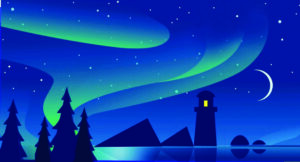Canadian residents should look to the north this upcoming year, as they may be able to catch a glimpse of colourful dancing lights in the night sky. Although these lights are visible several times a year as far south as the United States, chances will be significantly elevated starting from 2024 to mid-2025. The National Oceanic and Atmospheric Association (NOAA) states that the solar maximum is forecasted to occur later this year, which will increase light shows.
The science behind the aurora borealis is essential for forecasters to better predict when the northern lights will arise, along with their strength, speed, and overall visibility. To understand them, the sun’s activity and its effect on Earth’s magnetic field must be considered. When the sun undergoes solar coronal mass ejections, billions of tons of solar plasma with its very own magnetic field can barrel toward Earth within several days. This activity brings the most powerful geometric storms to the planet. It can pull Earth’s magnetic field like a rubber band, which then recoils causing Alfvén waves. Electrons will hitch a ride on these fast-traveling waves and collide with nitrogen and oxygen in Earth’s upper atmosphere, causing them to move into an excited state. The particles will release light once they settle down, causing the aurora borealis around the planet’s poles. When the sun reaches a solar maximum, its activity will increase, and the probability of large geometric storms will undoubtedly enhance.

Every nine to fourteen years, a solar maximum will occur. As the last peak happened in 2014, Solar Cycle 25 had begun to climb to its peak in 2019. Over several years, the sun’s activity has grown and will likely reach its summit by October of 2024. Tracking these shifts in energy is not only important for predicting northern lights, but they are also crucial for foreseeing potential hazards, such as interferences with the electrical grid, GPS signals, satellites’ orbits, and radiation exposure for airline crews and astronauts. When these storms intensify every cycle, these risks are at an increased cause for concern.
Geometric storms may be formidable, but they are also impressively beautiful. Depending on the strength, speed, and intensity of a storm, northern lights can be seen much farther south than the Arctic Circle. Intense streaks of green and pink light were seen in southern New Brunswick for many nights in 2023. There was an instance in April where the lights were at one of the highest strengths on the KP index and were visible as far as Mexico. Several other factors can also influence visibility, such as view to the north, light pollution, and weather conditions. For those who are interested in aurora hunting, all factors should be considered.
There are a couple of apps that you can use to track geometric activity and aurora probability. “My Aurora Forecast & Alerts” as well as “Aurora Alerts Canada – Norther” are both great tools for forecasting in your region. I also recommend keeping up to date on the “Astronomy by the Bay” Facebook page. Predictions may not always be true, as it is impossible to predict auroras at 100 percent accuracy. Despite the variability, this increased chance of visibility should be taken advantage of, as it will not happen for another decade.





